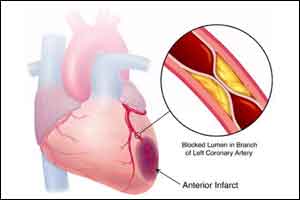- Home
- Editorial
- News
- Practice Guidelines
- Anesthesiology Guidelines
- Cancer Guidelines
- Cardiac Sciences Guidelines
- Critical Care Guidelines
- Dentistry Guidelines
- Dermatology Guidelines
- Diabetes and Endo Guidelines
- Diagnostics Guidelines
- ENT Guidelines
- Featured Practice Guidelines
- Gastroenterology Guidelines
- Geriatrics Guidelines
- Medicine Guidelines
- Nephrology Guidelines
- Neurosciences Guidelines
- Obs and Gynae Guidelines
- Ophthalmology Guidelines
- Orthopaedics Guidelines
- Paediatrics Guidelines
- Psychiatry Guidelines
- Pulmonology Guidelines
- Radiology Guidelines
- Surgery Guidelines
- Urology Guidelines
PPIIM protocol leads to safe intubation ,better outcomes in cardiogenic shock

The PPIIM protocol allows safe intubation of acute myocardial infarction patients with cardiogenic shock and improves hemodynamic and oxygenation parameters, according to a study recently published in the Canadian Journal of Cardiology.
Cardiogenic shock is a life-threatening condition in which the patients might require rapid sequence induction (RSI) and mechanical ventilation.
Athanasios Chalkias et al. conducted a study to evaluate a new RSI/mechanical ventilation protocol in patients with acute myocardial infarction complicated by cardiogenic shock.
The study included consecutive adult patients who were transferred to the emergency department. The RSI protocol included 5 phases: preoxygenation, pretreatment, induction/paralysis, intubation, and mechanical ventilation (PPIIM). As inference, the investigators selected historical patients managed with standard RSI as a control group. 31 consecutive patients who were intubated using the PPIIM protocol and 22 historical controls were studied.
Read Also: Epinephrine linked to threefold mortality risk in Cardiogenic shock
The primary outcome was hemodynamic derangement or hypoxemia from enrollment until the intensive care unit (ICU) admission.
Key study findings:
- Significant differences in systolic (85.32 ± 4.23 vs 71.72 ± 7.98 mm Hg), diastolic (58.84 ± 5.84 vs 39.05 ± 5.63 mm Hg), and mean arterial pressure (67.71 ± 4.90 vs 49.90 ± 5.66 mm Hg), as well as in partial pressure of oxygen (85.80 ± 19.82 vs 164.73 ± 43.07 mm Hg) between the PPIIM and control group at 5 minutes of automated ventilation.
- Also, statistically significant differences were observed in diastolic (59.74 ± 4.93 vs 47.86 ± 11.47 mm Hg) and mean arterial pressure (68.65 ± 4.10 vs 60.23 ± 11.67 mm Hg), as well as in partial pressure of oxygen (119.84 ± 50.57 vs 179.50 ± 42.17 mm Hg), and partial pressure of carbon dioxide (39.81 ± 10.60 vs 31.00 ± 9.30 mm Hg;) between the 2 groups at ICU admission.
- Compared with the control group, with PPIIM more patients survived to ICU admission (100% vs 77%) and hospital discharge (71% vs 31.8%), as well as at 90 days (51.6% vs 18.2%), and at 180 days (38.7% vs 13.6%).
Cardiogenic shock is a condition in which the heart suddenly is not able to pump enough blood to meet the body's requirements. The condition may be the outcome of a severe heart attack, but not everyone who has a heart attack has cardiogenic shock. Cardiogenic shock is rare, but it's often fatal if not treated immediately.
For reference log on to https://doi.org/10.1016/j.cjca.2018.04.015

Disclaimer: This site is primarily intended for healthcare professionals. Any content/information on this website does not replace the advice of medical and/or health professionals and should not be construed as medical/diagnostic advice/endorsement or prescription. Use of this site is subject to our terms of use, privacy policy, advertisement policy. © 2020 Minerva Medical Treatment Pvt Ltd